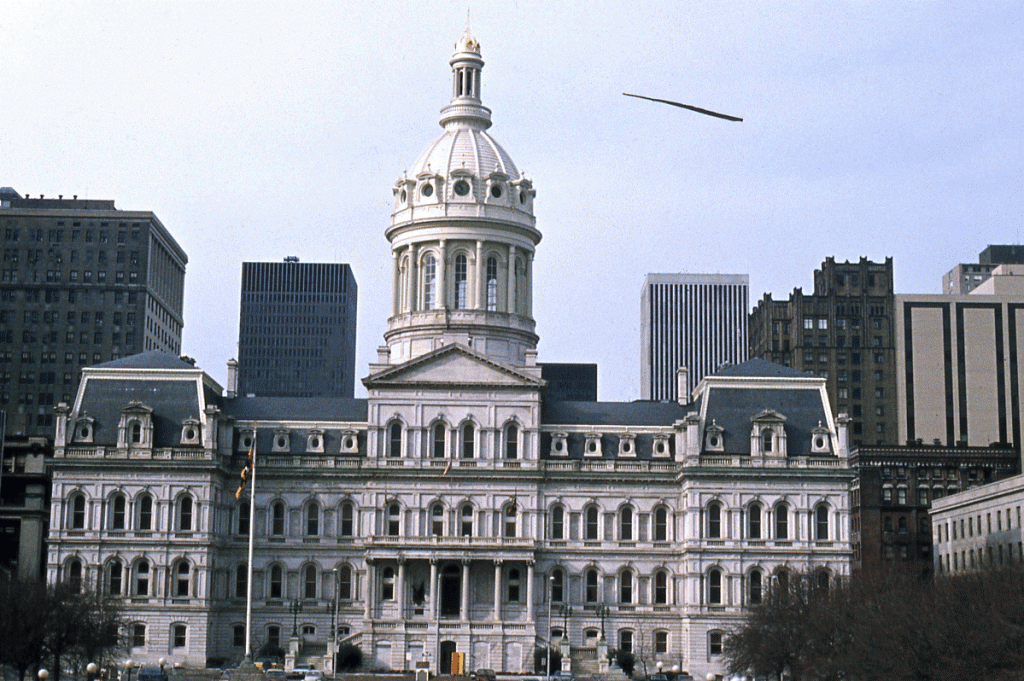This week’s entry in our Baltimore Building of the Week series from Dr. John Breihan features the Baltimore City Hall,

Although it imitates the arrangement of the U.S. Capitol – central dome and symmetrical side wings, the Baltimore City Hall is covered in French architectural elements, including banded rustication, arched windows, and a crowning Mansard roof. How did this come about?
Between 1861 and 1865 the American Civil War retarded most building projects. By the time it ended, tastes had changed. Although the Italianate style remained popular (especially in conservative Baltimore), the antebellum Greek and Gothic Revival styles faded away. Indeed, this whole era in American architecture bears a European name: “Victorian,” for the queen of Great Britain, 1837-1901. Victorian buildings showed off the new products of the industrial revolution then pouring forth a wealth of new building products – cheaper bricks and cut stone, encaustic tiles and terracotta, various forms of structural iron.
The Victorian style from France is named for the Second Empire of the Emperor Louis-Napoleon Bonaparte, who styled himself Napoleon III. It was this Napoleon who extended the Louvre and laid out the boulevards and sewers that made Paris the most modern city in the world in the late 19th century. The Second Empire style became very popular for government buildings after the Civil War; it was sometimes called the “General Grant” style after the 18th President. In Baltimore, George A. Frederick’s design, completed in 1875, employed a good deal of cast iron, including the 227-foot tall dome designed by Wendel Bollman and cast by Bartlett, Robbins, and Company.
About 75 years after their construction, Victorian buildings inevitably came to be seen as downright ugly. In Baltimore, the construction of the Abel Wolman Municipal Building overshadowed City Hall, blocking any views from the north. In the 1970s, demolition of City Hall was seriously discussed. But wiser heads prevailed, and a prize-winning renovation equipped City Hall for continued use as the center of Baltimore’s government.

Dr. Breihan, in his comments on Baltimore’s City Hall, states that …” it was this Napoleon who extended the Louvre and laid out the boulevards and sewers that made Paris the most modern city …”. I believe it may be more correct to give credit to the German engineer Baron Georges-Eugene Haussmann. Between 1852 to 1870, Baron Haussmann designed and laid out streets and boulevards, parks,water and sewer systems, monuments, and even designed the facades of buildings. Up until the 1850’s Paris was a city of narrow, dark and irregular alleyways that had existed since medieval times. No city of light at this time. The point is that Napoleon gave full control of the redesign of Paris to Baron Haussman. So it can be said the look of todays Paris, which French people rightfully take immense pride in, is due mostly to a German. I would like to point out the height restrictions, which keep the buildings at a uniform level. Many critics consider cities which have uniform height restrictions, such as Florence and Washington, D.C., to be among the worlds most beautiful. I personally think it’s garish and visually upsetting to have a hughe skyscraper towering over historically preserved three story or less buildings. A trip to Philadelphia will illustrate this concept. Hughe office towers glare down at rowhouses on the next block, a hotel looms over a historic church, and so on.